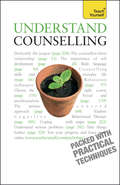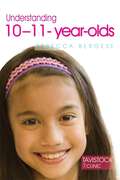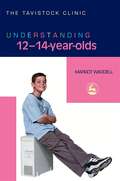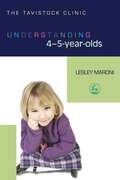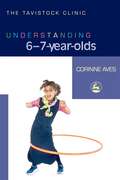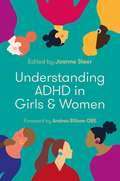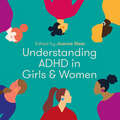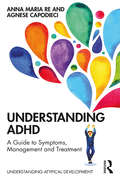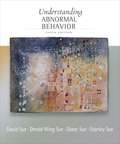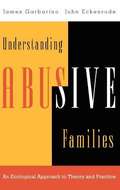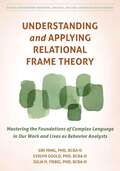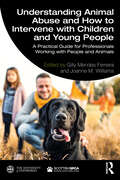- Table View
- List View
Understand Body Language: Teach Yourself
by Gordon WainwrightTeach Yourself - the world's leading learning brand - is relaunched in 2010 as a multi-platform experience that will keep you motivated to achieve your goals. Let our expert author guide you through this brand new edition, with personal insights, tips, energising self-tests and summaries throughout the book. Go online at www.teachyourself.com for tests, extension articles and a vibrant community of like-minded learners. And if you don't have much time, don't worry - every book gives you 1, 5 and 10-minute bites of learning to get you started. - A bestseller, now fully updated with the very latest on body language and non-verbal communication - The only title to give you practical exercises to help you understand your own and other peoples' body language - Unlike other titles, this is not restricted to the workplace but shows you how to understand what other people are saying in every social and domestic situation - Includes the very latest on NLP and how to communicate more effectively through its useWe all use body language. Over 90% of all face-to-face communication is non-verbal, and the silent messages of body language often reveal more than the spoken word in conveying true feelings. These messages are particularly significant in influencing first impressions and the self-image we project to others.Now updated for the 21st century with the very latest on NLP and other cutting edge research, Teach Yourself Body Language gives you the knowledge and understanding to be able to use and interpret body language more effectively. It includes practical exercises that will enhance your understanding of non-verbal communication, and it also explores the use of body language in personal and professional situations.All aspects of body language are covered including features of the workplace and features exhibited in an international context.
Understand Body Language: Teach Yourself (Teach Yourself General)
by Gordon WainwrightTeach Yourself - the world's leading learning brand - is relaunched in 2010 as a multi-platform experience that will keep you motivated to achieve your goals. Let our expert author guide you through this brand new edition, with personal insights, tips, energising self-tests and summaries throughout the book. Go online at www.teachyourself.com for tests, extension articles and a vibrant community of like-minded learners. And if you don't have much time, don't worry - every book gives you 1, 5 and 10-minute bites of learning to get you started. - A bestseller, now fully updated with the very latest on body language and non-verbal communication - The only title to give you practical exercises to help you understand your own and other peoples' body language - Unlike other titles, this is not restricted to the workplace but shows you how to understand what other people are saying in every social and domestic situation - Includes the very latest on NLP and how to communicate more effectively through its useWe all use body language. Over 90% of all face-to-face communication is non-verbal, and the silent messages of body language often reveal more than the spoken word in conveying true feelings. These messages are particularly significant in influencing first impressions and the self-image we project to others.Now updated for the 21st century with the very latest on NLP and other cutting edge research, Teach Yourself Body Language gives you the knowledge and understanding to be able to use and interpret body language more effectively. It includes practical exercises that will enhance your understanding of non-verbal communication, and it also explores the use of body language in personal and professional situations.All aspects of body language are covered including features of the workplace and features exhibited in an international context.
Understand Counselling: Learn Counselling Skills For Any Situations
by Aileen MilneUnderstand Counselling will give you a clear understanding of the main counselling theories and help you develop vital counselling skills. It will introduce you to the three main branches of counselling - psychodynamic therapy, person-centred therapy and cognitive behavioural therapy - and familiarize you with the key features of each one. Whether you are interested in training as a counsellor, are considering counselling yourself or simply want to become a better communicator, this book will give you confidence and understanding.NOT GOT MUCH TIME?One, five and ten-minute introductions to key principles to get you started.AUTHOR INSIGHTSLots of instant help with common problems and quick tips for success, based on the author's many years of experience.TEST YOURSELFTests in the book and online to keep track of your progress.EXTEND YOUR KNOWLEDGEExtra online articles at www.teachyourself.com to give you a richer understanding of counselling.FIVE THINGS TO REMEMBERQuick refreshers to help you remember the key facts.TRY THISInnovative exercises illustrate what you've learnt and how to use it.
Understand Counselling: Learn Counselling Skills For Any Situations (Teach Yourself Educational Ser.)
by Aileen MilneUnderstand Counselling will give you a clear understanding of the main counselling theories and help you develop vital counselling skills. It will introduce you to the three main branches of counselling - psychodynamic therapy, person-centred therapy and cognitive behavioural therapy - and familiarize you with the key features of each one. Whether you are interested in training as a counsellor, are considering counselling yourself or simply want to become a better communicator, this book will give you confidence and understanding.NOT GOT MUCH TIME?One, five and ten-minute introductions to key principles to get you started.AUTHOR INSIGHTSLots of instant help with common problems and quick tips for success, based on the author's many years of experience.TEST YOURSELFTests in the book and online to keep track of your progress.EXTEND YOUR KNOWLEDGEExtra online articles at www.teachyourself.com to give you a richer understanding of counselling.FIVE THINGS TO REMEMBERQuick refreshers to help you remember the key facts.TRY THISInnovative exercises illustrate what you've learnt and how to use it.
Understand Psychology: Teach Yourself (Teach Yourself)
by Nicky HayesA FASCINATING INSIGHT INTO WHAT MAKES US TICKThe bestselling Understand Psychology explains basic psychological processes and how they influence us in all aspects of everyday life. It explores why we are the way we are, how we came to be that way, and what we might do to change seemingly fundamental traits. The book puts psychology in context, using non-technical language to analyze everyday situations. It is a comprehensive introduction that shows how human experience can be understood on many levels.Understand Psychology takes you through every aspect of the subject, from child development and social influences to the role of memories and emotions. You will discover how we interact with each other, why we dream, what motivates us, why children need to play and whether watching TV is bad for you.Now fully revised and updated, this 6th edition of the bestselling guide includes brand new material on mindfulness, social living, focusing in particular on shyness and loneliness and social media, coping with stress, decision making and forensic psychology, addiction and modern drugs, cognitive neuropsychology, and the psychology of learning, including teaching, exams and exam stress.The clear structure, packed full of practical examples, makes it easy to learn the essentials you really need to know.ABOUT THE SERIESPeople have been learning with Teach Yourself since 1938. With a vast range of practical, how-to guides covering language learning, lifestyle, hobbies, business, psychology and self-help, there's a Teach Yourself book for whatever you want to do. Join more than 60 million people who have reached their goals with Teach Yourself, and never stop learning.
Understand Your Dreams
by Alice Anne ParkerThis revised and updated edition of a classic book on dream interpretation includes 500 more images and a new three-step process for understanding the messages of your subconscious mind. Divided into four sections, Understand Your Dreams includes: an introduction to dreams with directions for using the book, a short-cut method of interpreting your dreams, a longer eight-step method for deeper interpretation, and a glossary with more than 2000 images from A to Z. In the vocabulary section, each entry includes common associations for the image and questions to ask yourself to understand the image in the context of your own life and dream. For example, the association for "zombie" is "living death" and the question is "What am I afraid to let go of?" For "scissors": "feminine weapon; separation" and "What do I wish to cut out?" The format is inviting and interesting reading, and, based on the letters the author receives, the work has proven to be useful for thousands of readers for the past 10 years. What makes Understand Your Dreams unique? Alice Anne Parker has developed a proven technique to recall and record dreams while they are still fresh in the dreamer's mind by grouping similar images, feelings, and characters into affinity circles. By pinpointing the feelings and images of dreams and identifying them with the dreamer's waking life, readers gain insights into their own subconscious. The extensive dream dictionary shows how dream images trigger pivotal questions that stimulate ideas and associations in the reader -- something that mere definitions cannot. Parker goes on to guide the reader into developing a personal dream vocabulary and explains how to work with a partner or lover to cultivate "active dreaming."
Understanding 10-11-Year-Olds
by Jonathan Bradley Rebecca BergeseUnderstanding 10-11-Year-Olds introduces the challenges that face children as they start to make their transition from childhood into adolescence. Children at this age begin to express independence and confidence in their capability that may extend beyond their direct experience. Adults caring for their well-being need to monitor the new dimensions in the child's life, such as competitiveness and its impact on relationships at school and at home. Rebecca Bergese guides the reader through the broad range of emotional and social challenges experienced by children as they are encouraged to take on greater responsibility. This book is essential reading for parents, carers and professionals who are seeking to understand and support a child at this vulnerable stage of development.
Understanding 12-14-Year-Olds
by Margot Waddell Jonathan BradleyHow much independence should parents allow teenagers who claim rights and privileges, show excessive confidence and test the boundaries of discipline? How can parents handle the physical and emotional changes in their adolescent child? This book offers helpful advice to parents whose children have reached the turbulent teenage years. From conflict management to issues of bullying, stealing and smoking, it guides parents as their children alternate between maturity and immaturity and develop their own identity. It explains the impact of school life, group pressures and close friendships on 12-14-year-olds' development and helps parents to offer their child support, while accepting his or her increased need for privacy. Alongside these challenges, the author reveals the rewards of sharing in these young people's enthusiasm and ambitions, as they grow more confident and responsible. This book provides practical and sensitive advice for parents to help them relate to and communicate with their child at a difficult time of transition, while being prepared to question what they thought they already knew about their son or daughter - and about parenting.
Understanding 4-5-Year-Olds
by Jonathan Bradley Lesley MaroniUnderstanding 4-5-year-olds gives a thoughtful overview of the challenges that children face as they gradually move away from a strong attachment to their families and turn towards the wider world of school and life outside the family. Lesley Maroni discusses the critical social and emotional developments at this age, including identity, independence and sibling rivalry, the transition to school and friendships with peers, coping with illness and loss, and gender differences. The author also shows how 4-5-year-olds explore real issues using the protective safety of pretend play and their imagination. This accessible book provides valuable insights and a wealth of case examples that will help parents, educators and carers better understand and relate to children at this demanding, yet exciting, stage of development.
Understanding 6-7-Year-Olds
by Jonathan Bradley Corinne AvesWhat challenges do 6-7-year-olds face as they learn new skills and face different social situations? How do their perceptions of the world change? How can we best support them in their move towards greater independence? This accessible book provides a wealth of information to help parents, educators and carers better relate to children at this exciting, yet demanding, stage of development. From the new-found sense of rivalry between siblings or classmates, to the anxieties children feel when making new friends, Corinne Aves offers guidance on encouraging children's development and helping them to cope with changing expectations of their behaviour. She discusses the various struggles in these children's lives – such as the conflict between a child's continuing desire to please his parents and the pressure to follow the leads of his friends – and gives tips for supporting children's increasing understanding of morality. Chapters on both school and family life explain the need for discipline and order in 'middle childhood', while specific areas of development such as reading skills and learning difficulties are addressed with sensitivity and insight. Understanding 6-7-Year-Olds will prove an enlightening read for anyone hoping to better understand children at this important stage of their lives.
Understanding 8-9-Year-Olds
by Jonathan Bradley Biddy YouellUnderstanding 8-9-Year-Olds describes how children grow and change as they move further away from reliance on home and family, out into the world of school and community. Children of this age develop preferences as well as opinions based on their experience of new relationships and activities. For many children, it is a period of relative calm as they develop through new skills while accumulating knowledge. Biddy Youell looks at the ways in which eight and nine year olds experience their world and highlights some of the difficulties that may hinder their emotional, social or educational development. This accessible book provides valuable insights that will help parents, educators and carers better understand and relate to children during these middle years of childhood.
Understanding ADHD in Girls and Women
by Peter Hill Sally Cubbin Claire Berry Jess Brunet Alex Doig Eva Akins Valerie Ivens Allyson ParryWritten by expert professionals, this book provides comprehensive information about available support for women and girls with ADHD and tips for clinicians and professionals who work with them.The symptoms of ADHD are no less impairing in females than males, but can be missed or misunderstood. This book arms professionals, parents, and women themselves as it maps out where to go for information, who can help and how to understand ADHD better. It explains routes to assessment and diagnosis for girls and young women, how to access support in education, available treatments, and the impact of living with ADHD on overall mental health. It explores the benefits of ADHD coaching for girls to help develop their unique strengths and talents. There is also a focus on ADHD diagnosis for women in adulthood and specific advice about treatment and medication for later in life. Central to the book are the personal experiences of ADHD from women and girls from a variety of backgrounds. These tell of late diagnosis, missed opportunities, a lifetime of adaptations and the power of recognition and treatment and are powerful stories for professionals and individuals with ADHD alike.
Understanding ADHD in Girls and Women
by Peter Hill Sally Cubbin Claire Berry Jess Brunet Alex Doig Eva Akins Valerie Ivens Allyson ParryInsights and best practice for professionals on ADHD in girls and women. Written by expert professionals, this book provides comprehensive information about available support for women and girls with ADHD and tips for clinicians and professionals who work with them.The symptoms of ADHD are no less impairing in females than males, but can be missed or misunderstood. This book arms professionals, parents, and women themselves as it maps out where to go for information, who can help and how to understand ADHD better. It explains routes to assessment and diagnosis for girls and young women, how to access support in education, available treatments, and the impact of living with ADHD on overall mental health. It explores the benefits of ADHD coaching for girls to help develop their unique strengths and talents. There is also a focus on ADHD diagnosis for women in adulthood and specific advice about treatment and medication for later in life. Central to the book are the personal experiences of ADHD from women and girls from a variety of backgrounds. These tell of late diagnosis, missed opportunities, a lifetime of adaptations and the power of recognition and treatment and are powerful stories for professionals and individuals with ADHD alike.(P) 2021 Hodder & Stoughton Ltd
Understanding ADHD: A Guide to Symptoms, Management and Treatment (Understanding Atypical Development)
by Anna Maria Re Agnese CapodieciThis essential guide provides accessible, concise, evidence-based guidelines on Atttention Deficit Hyperactivity Disorder (ADHD), offering a deeper scientific understanding of the condition and its consequences. It offers ideas and insights for managing the condition in daily family life and promoting the most effective self-regulation strategies for children and adolescents, allowing parents to better understand the origins of their child’s behaviour and avoid potential negative consequences. In this straightforward text, Capodieci and Re set out the basic theories on ADHD and cover key topics including parent-child relationships, helping children understand their condition, friendships with peers, comorbidities, classroom strategies, and how families and professionals can best work together. Taking into account the most recent updates to the DSM-5 definition of ADHD, the authors emphasise the importance of a multifocal approach to the treatment of ADHD, involving the child’s teachers, parents and peers, to better develop family and peer relationships. They offer strategies for the classroom, for good sleep and for healthy eating and physical activity, and support for any other learning, language, movement and emotional problems an ADHD child might have. Understanding ADHD will be essential reading for parents of children with ADHD, as well as health, education and social care professionals involved in the field.
Understanding Abnormal Behavior
by David Sue Stanley Sue Derald Sue Diane SueFeaturing current research, high-quality scholarship, and an appealing design, UNDERSTANDING ABNORMAL BEHAVIOR, 10th Edition, provides an inviting and stimulating look into abnormal psychology. The first abnormal psychology book to present a thoroughly integrated multicultural perspective -- based on the authors' view that cross-cultural comparisons can greatly enhance the understanding of disorders -- the text provides extensive coverage and integration of multicultural models, explanations, and concepts. It also continues the multipath model introduced in the 9th edition, emphasizing the importance of considering biological, psychological, social, and sociocultural factors, as well as their interactions in the etiology of mental disorders. The book helps you gain an understanding of abnormal behavior as scientific and clinical endeavors, while providing insight into the tools that mental health professionals use to study and treat disorders. It also begins to discuss the proposed changes in the APA's DSM-5 definition of mental disorders and its implications, including its change of focus from a categorical to a dimensional system of personality assessment.
Understanding Abnormal Psychology: Clinical and Biological Perspectives
by Pamilla RamsdenUnderstanding Abnormal Psychology provides a thorough understanding of abnormal psychology with a focus on the integration of psychology, biology and health. It goes beyond a descriptive overview of clinical disorders to provide a critical appreciation of the multifaceted aspects of mental illness. Each disorder is clearly and succinctly explained with the support of case studies. These examples are then used to introduce the debates surrounding current research, the biology of abnormal disorders and standards of treatment. The bridge between the biological elements of brain functioning and the psychological mechanisms that are responsible for coping and adjustment is thoroughly explored. This valuable consideration of the range of elements involved in the diagnosis and treatment of clinical disorders will provide you with a broad and critical understanding of this complex and fascinating field. Visit the companion website at www.sagepub.co.uk/ramsden with a number of useful features for students, including a flipcard glossary of key terms from the textbook and a test bank of interactive self-assessment multiple-choice questions.
Understanding Abusive Families: An Ecological Approach To Theory And Practice
by James Garbarino John EckenrodeAn up-to-date analysis of the factors contributing to abuse <p><p> This newly revised edition of a classic in the field of child abuse and neglect presents effective guidelines for prevention, protection, and rehabilitation. <p> Compelling and compassionate, this book explores why and how families become abusive. It then offers both the wisdom and specific clinical interventions that will aid in the understanding of abuser and victim.
Understanding Adolescents’ Political Agency: Examining How Political Interest Shapes Political Development (Studies in Adolescent Development)
by Håkan StattinThis ground-breaking volume shows that young people largely shape their own political development, and that to understand young people's political development, we must consider their political agency.Håkan Stattin explores the findings of an extensive longitudinal study of the political socialization of young people in Sweden from the ages of 13 to 28, which shows that, contrary to popular belief, it is not parents, peers, teachers or other key adults who are the primary agents in shaping young people's political development; it is their own self-directed political interest. Given that political interest is both an input and an output, the book examines how political interest affects young people's political interactions with their parents, and why young people and their parents perceive these interactions differently. It covers key issues such as the impact of political-interest-triggering events and civil unrest, the role of school and peers, parental involvement and the path from political interest to future political and civic engagement.Launching a new field of research internationally, this volume is essential reading for researchers, students, educators, and policy developers interested in young people's political and civic attitudes, engagement, communication, core values and the emergence of intrinsic political sophistication.
Understanding Adult Attachment in Family Relationships: Research, Assessment and Intervention
by Antonia Bifulco Geraldine ThomasAttachment theory has become a key focus of both research and practice in understanding and treating psychological and social risk for marital and relationship problems, parenting and clinical disorders. In particular, adult attachment style is a key explanatory factor for understanding problems in human relationships. This practical book introduces and explains an easily accessible assessment tool for adult attachment style, the Attachment Style Interview (ASI). Based on extensive research study, it discusses appropriate interventions and case assessments that can be made to help families in need. Simpler than the Adult Attachment Interview, which requires expert administration, the ASI is an invaluable and evidence-based resource. Presenting clear and concise descriptions of the measure and summaries of the attachment models developed, this text provides discussions of its relevance for different practice contexts, and uses a range of worked case studies to illustrate its principles and applications. It details attachment issues in different relationship domains to cover areas of risk and resilience relevant for practice such as: Adult depression and anxiety and stress models, Partner difficulties including domestic violence, Childhood neglect and abuse as a source of attachment problems, Parenting and intergenerational transmission of risk, Interventions, service application and use in family therapy. Understanding Adult Attachment in Family Relationships provides an important reference for all practitioners working with children, adolescents and families, especially those undertaking further study.
Understanding Ageing for Nurses and Therapists (Perspectives in Nursing Management and Care for Older Adults)
by Wilfred McSherry Linda Rykkje Susan ThorntonThis volume is a practical resource for all those responsible for caring for older people across health and social care. It provides a comprehensive and holistic approach helping nurses, therapists and social care professionals to better understand the impact of ageing upon the person and wider society. A unique feature of this text is the focus upon positive ageing and the attempt to dispel and challenge some of the myths, prejudices and negative attitudes that still prevail towards ageing and older people. A key objective of the book is to introduce practitioners to some of the neglected or under-addressed aspects of ageing such as spirituality, sexuality, and LGBT.Chapters are written in an engaging and interactive style and where appropriate draw upon case studies and scenarios to maximize engagement developing competence, by informing knowledge, attitudes and skills. The text introduces the practitioner to key dimensions of what it is to be a person, physically, psychologically, socially and spiritually and how these contribute to the ageing process and can enhance the quality of life of older people.Irrespective of whether one cares for older people in an acute hospital setting or domiciliary, home care, this text will be of relevance. The material and content transcend health and social care boundaries, providing valuable, contemporary evidence that can inform and shape practice. Above all this text will encourage reflection, dialogue and engagement with some fundamental aspects of ageing, challenging, attitudes, values and behaviour so that a more positive and balanced insight towards ageing is fostered. This book will ensure that self-awareness and professional practice are enriched and informed and the practitioner has a holistic understanding of ageing that will enable them to care for older people with compassion, dignity and respect.
Understanding Analysis and its Connections to Secondary Mathematics Teaching (Springer Texts in Education)
by Stephen Abbott Nicholas H. Wasserman Timothy Fukawa-Connelly Keith Weber Juan Pablo Mejía RamosGetting certified to teach high school mathematics typically requires completing a course in real analysis. Yet most teachers point out real analysis content bears little resemblance to secondary mathematics and report it does not influence their teaching in any significant way. This textbook is our attempt to change the narrative. It is our belief that analysis can be a meaningful part of a teacher's mathematical education and preparation for teaching. This book is a companion text. It is intended to be a supplemental resource, used in conjunction with a more traditional real analysis book.The textbook is based on our efforts to identify ways that studying real analysis can provide future teachers with genuine opportunities to think about teaching secondary mathematics. It focuses on how mathematical ideas are connected to the practice of teaching secondary mathematics–and not just the content of secondary mathematics itself. Discussions around pedagogy are premised on the belief that the way mathematicians do mathematics can be useful for how we think about teaching mathematics. The book uses particular situations in teaching to make explicit ways that the content of real analysis might be important for teaching secondary mathematics, and how mathematical practices prevalent in the study of real analysis can be incorporated as practices for teaching.This textbook will be of particular interest to mathematics instructors–and mathematics teacher educators–thinking about how the mathematics of real analysis might be applicable to secondary teaching, as well as to any prospective (or current) teacher who has wondered about what the purpose of taking such courses could be.
Understanding And Applying Relational Frame Theory: Mastering The Foundations Of Complex Language In Our Work And Lives As Behavior Analysts
by Siri Ming Evelyn Gould Julia H. FiebigA comprehensive treatise on how to understand complex language, and use language effectively as a behavior analyst. Language changes everything. From infancy through adulthood, language shapes how we live our lives and interact with other people, in increasingly complex ways. Language also shapes how we exist in the world as professionals—and how we operate as a profession. As behavior analysts working with others to effect change, words matter. A comprehensive understanding of complex language is therefore critical to practicing effectively as a behavior analyst. Understanding the functions of complex language, allows us to skillfully use language as an intervention tool. Relational frame theory (RFT) is a behavior analytic theory of human language. RFT suggests that the building block of human language and higher cognition is relating—in other words, the human ability to create links between one thing and another using words. Understanding and Applying Relational Frame Theory outlines the essential principles of RFT, and offers practical applications and tools to help clients live better lives and to establish the conditions necessary for all of us to thrive. With a central focus on establishing psychological flexibility, prosociality, and cooperative contexts for change, at all levels of analysis—from the self to overarching systems and cultures—in this book, you will: Learn the theoretical basis of RFT, including how relational operants are learned, from their roots in early social interactions to the complex relating of relations and relational networks seen in analogical and metaphorical reasoning. Explore how complex verbal repertoires affect individual behavior, introducing the development of the self and the influence of rule-governed behavior and private events. Examine relational framing in the context of groups—including the speaking and listening skills needed for supervision, mentorship, effective messaging, and prosociality within and between organizational systems. Discover the implications of applying a behavior analytic understanding of complex language to a variety of settings, including education, mental health, and business. Learn how RFT can be applied to issues of diversity and inclusion, and global sustainability. Finally, you’ll find a thorough discussion of how behavior analysts can use the principles outlined in this book to extend the reach of the field into a range of socially significant and critical areas for behavior change.
Understanding Animal Abuse and How to Intervene with Children and Young People: A Practical Guide for Professionals Working With People and Animals
by Gilly Mendes Ferreira Joanne M. WilliamsUnderstanding Animal Abuse and How to Intervene with Children and Young People offers a positive, compassion-based and trauma-informed approach to understanding and intervening in animal abuse. It provides an accessible cross-disciplinary synthesis of current international evidence on animal abuse and a toolkit for professionals working with people and/or animals to help them understand, prevent and intervene in cases of animal abuse. With contributions from experts in the field, this essential text offers ten user-friendly chapters with questions for reflection and key summary points. It offers a definition of animal abuse, synthesises the latest research on children, young people and animal abuse, explores the link between animal abuse and other forms of abuse and outlines legal perspectives on animal abuse. The second half of the book presents a practical toolkit for professionals, offering guidance and strategies for the prevention of and intervention in cases of animal abuse. It provides multidisciplinary perspectives on interventions; from teachers’ and social workers roles in detection and intervention of childhood animal abuse, to the roles of enforcement agencies and veterinarians in legal cases of adult animal abuse. Together with a final chapter proposing new directions for research, policy and practice, this guide is for all who work with children, young people and/or animals, including psychologists, social workers, veterinarians, education professionals and animal welfare educators. It is also a key reading for those involved in legal and policy issues relating to animal welfare.
Understanding Anorexia Nervosa in Males: An Integrative Approach
by Tom WooldridgeBecause anorexia nervosa has historically been viewed as a disorder that impacts women and girls, there has been little focus on the conceptualization and treatment of males suffering from this complex disorder. Understanding Anorexia Nervosa in Males provides a structure for understanding the male side of the equation combined with practical resources to guide clinical intervention. Presented using an integrative framework that draws on recent research and organizes information from multiple domains into a unified understanding of the interconnected issues at hand, this informative new text provides a comprehensive approach to understanding and treating a widely unrecognized population.
Understanding Anxiety, Worry and Fear in Childbearing: A Resource for Midwives and Clinicians
by Kathryn GutteridgeThis book informs and enlighten health professionals on how the recognition of fearing women can change their episode of care during childbearing. It gives practical advice on the way women present to services and the challenges that this invokes. This work is the first of its kind aimed at clinicians to deconstruct ideology around childbearing myths and its challenges. The authors review the evidence that exists and how modern maternity systems are responding to fear and shaping healthcare. Whilst some worry and anxiety is expected and indeed considered normal during childbearing, it has been suggested that this has now proliferated to a degree of abnormal for many women. Why is that and how is this panic spread? Media portrayal of birth is suggested as unrealistic material and to show only that which is dramatic and horrific. This has been considered as one factor influencing modern women. Medicalisation, technology and demand upon services is another consequence of providing almost all maternity care in hospitals. Given that the majority of childbearing women are fit and healthy is this another causative factor? By removing women from their homes and families at such a vulnerable time has a serious consequence for how she will experience her greatest leap of faith into motherhood. All of these issues are explored and examined in the book with ideas and practical suggestions of what may be done to change this increasingly common problem. This book is intended at midwives and clinicians working in maternity settings.

